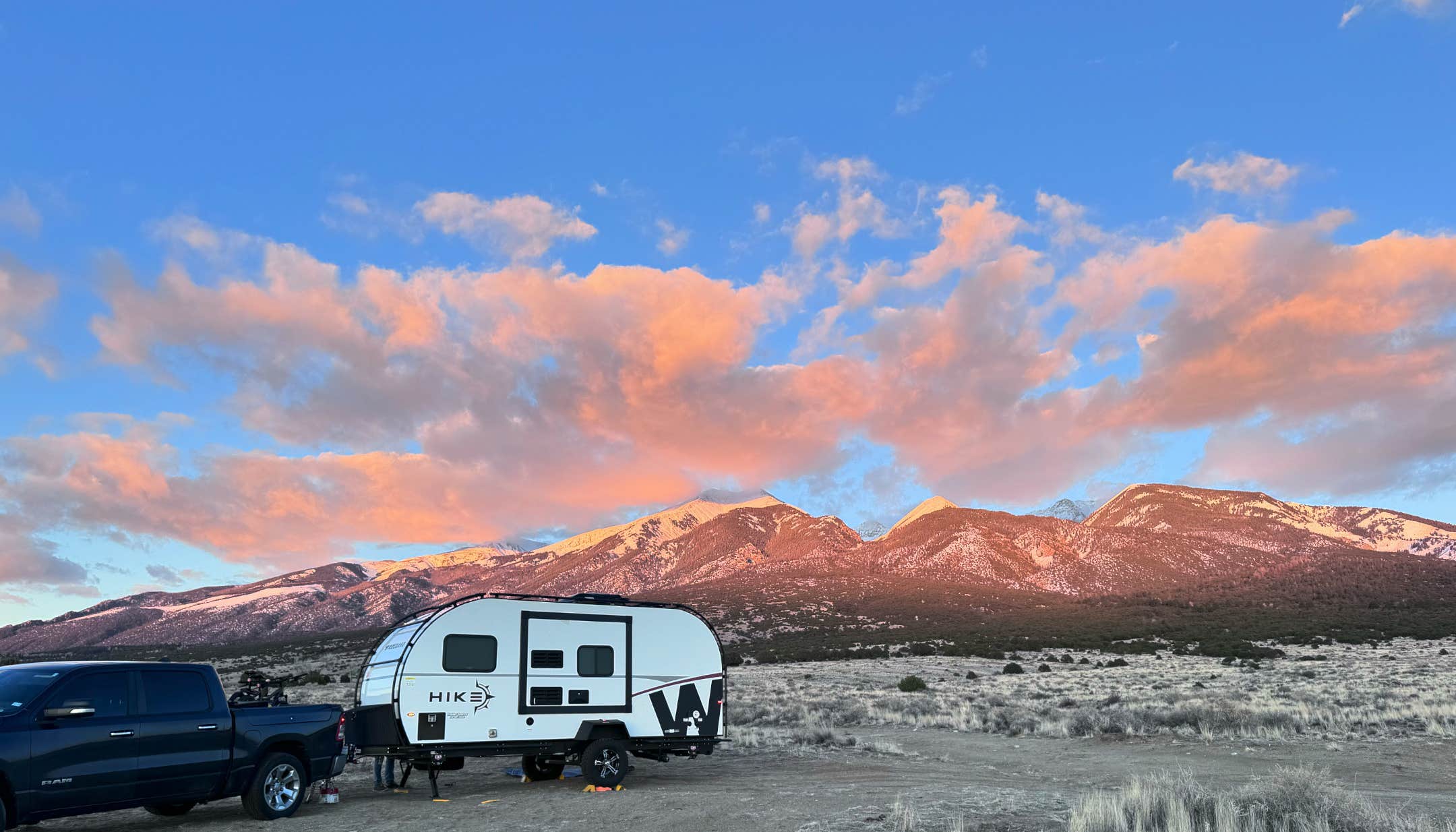Great Sand Dunes National Park and Preserve Camping Guide
Great Sand Dunes National Park & Preserve may be smaller than Yellowstone or Yosemite, but it offers a truly unique camping experience. From the towering 750-foot dunes to the alpine forests high above, campers can explore multiple ecosystems in one trip. You'll find just one developed campground inside the park (Piñon Flats) and plenty of more rustic or offbeat options nearby. Whether you camp along the seasonal Medano Creek "beach," drive a 4WD to remote sites, or set up a tent right on the dunes, this guide covers everything you need to know about planning an unforgettable Great Sand Dunes camping adventure.
Great Sand Dunes National Park Camping at a Glance
Unlike larger parks with dozens of campgrounds, Great Sand Dunes National Park camping keeps things simple. Piñon Flats Campground, one mile from the visitor center, is the park's main campground, offering 88 sites that book up quickly for summer. All other camping inside the park is more primitive: backpacking in the Dunefield requires a free permit, and Medano Pass Primitive Road features 21 first-come 4WD sites in the preserve. Outside the park, you'll find a mix of private campgrounds (like the Oasis at the park entrance) and public lands with dispersed camping near Great Sand Dunes. Nights are generally clear and perfect for stargazing thanks to the park's International Dark Sky designation, but temperatures swing from hot daytime sand to chilly evenings. Always arrive prepared with plenty of water, sun protection, and sturdy shelter against the famous afternoon winds.
Great Sand Dunes National Park Campground Quick Facts
| Quick Facts | Details |
|---|---|
| Number of Campgrounds | 1 developed campground (Piñon Flats) in-park; 21 primitive 4WD sites in National Preserve; numerous nearby campgrounds and dispersed areas |
| Total Campsites | Piñon Flats: 88 sites (several tent-only group sites available) Medano Pass Primitive Road: 21 numbered sites (tent or small RV with 4WD) Backcountry Dunefield: Unlimited, permit required (no designated sites) |
| Campsite Costs | Piñon Flats: $20 per night (standard site) Medano Pass 4WD sites: Free (park entrance fee required) Private campgrounds: ~$20-$45 (tent/RV sites); higher for cabins or glamping tents |
| Reservation Platforms | Recreation.gov for Piñon Flats (6-month rolling window) In-person permits for dunefield/backcountry at visitor center (free) No reservations for Medano Pass road sites (first-come) Private campgrounds via phone/online (Oasis, etc.) |
| Camping Seasons | Piñon Flats open April 1 - October 30 (closed in winter) Medano Pass road sites accessible late spring through fall (road closed by snow in winter/early spring) Backcountry dune camping year-round (permit required; winter access limited) |
| Temperature Ranges | Summer: Days 75-80°F (sand up to 150°F), Nights 40-50°F Spring/Fall: Days 50-70°F, Nights 20-40°F (wide variability; windy in spring) Winter: Days 20-40°F, Nights 0-15°F (below 0°F in coldest periods) |
| 2025 Updates | Piñon Flats accessible sites under renovation (Aug 2025) Zapata Falls Campground now requires reservation on Recreation.gov |
Great Sand Dunes Campgrounds: Complete Guide
In-Park Campgrounds & Camping Areas
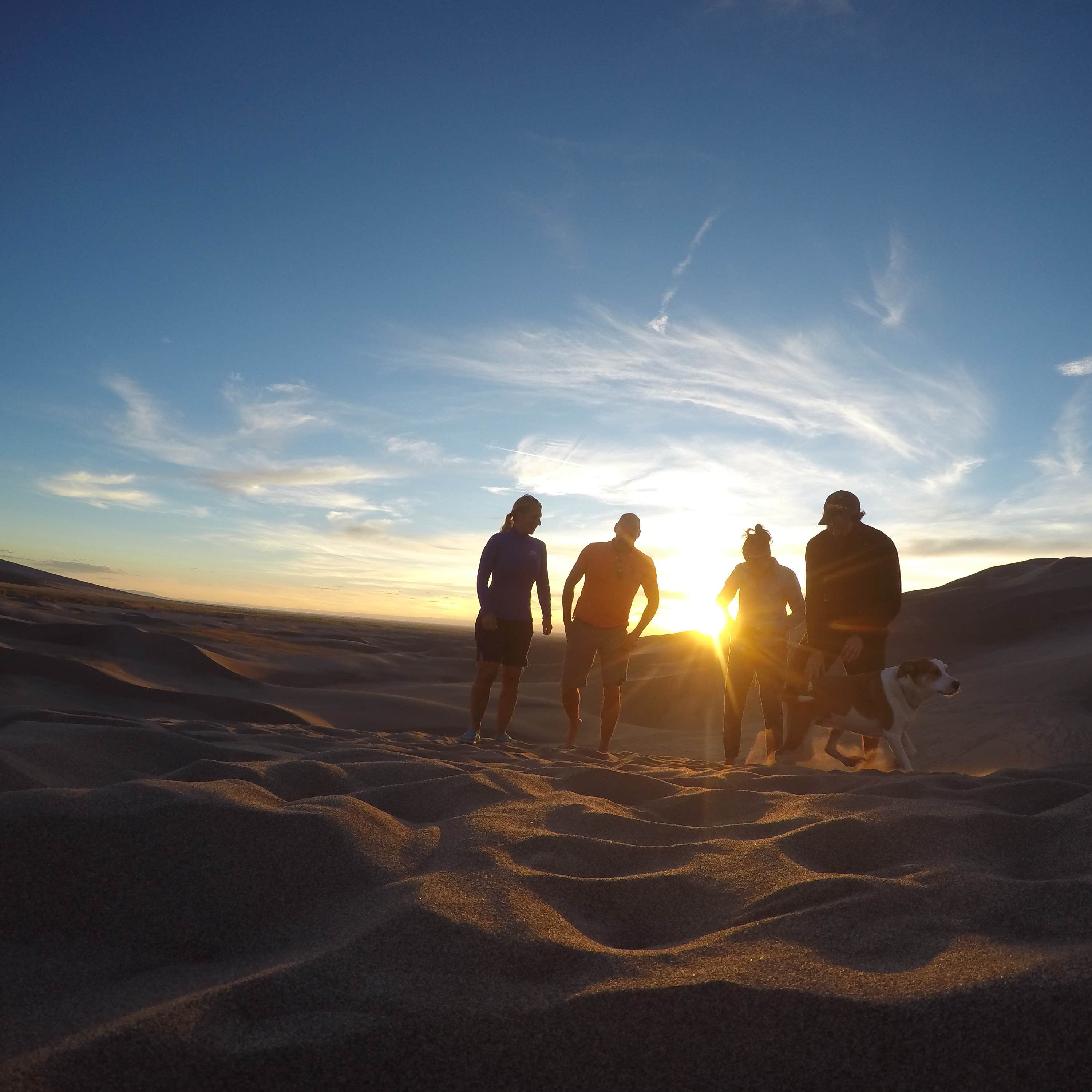
Pinon Flats Campground — Great Sand Dunes National Park
Piñon Flats Campground is the park's main campground, located walking distance from the dunes. Its 88 sites sit among pinyon pines and junipers at 8,200 feet elevation, offering picnic tables, fire grates, and nearby water spigots and restrooms (no showers or hookups). The campground opens April through October, with reservations required in advance. Sites are relatively close together with partial shade from the trees. Campers love the immediate access to the sand dunes and Medano Creek -- you can start your dune hike right from the campground. Expect warm days and chilly nights; even in mid-summer, overnight lows can drop into the 40s°F.
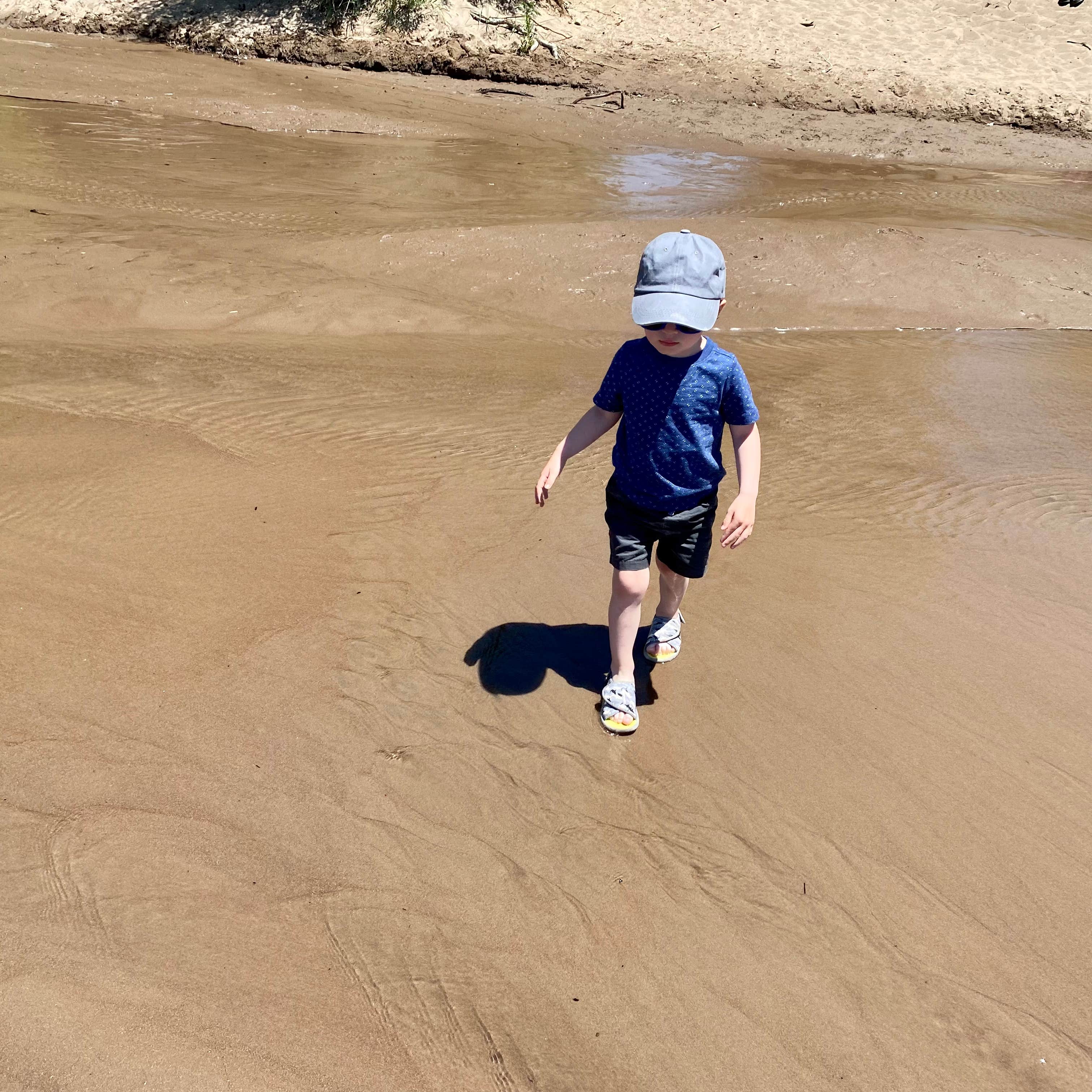
The Dunefield — Great Sand Dunes National Park
The Dunefield isn't a traditional campground at all, but rather an open backcountry zone on the dunes where permitted backpackers can camp anywhere beyond 1.5 miles from the main day-use area. This is a true wilderness experience on 30 square miles of sand. There are no designated sites -- you'll be carrying your gear up and over shifting dunes to find a suitable spot. It's hard work hiking in soft sand, but the rewards are immense: complete solitude, unbelievable starry skies, and sunrise from atop the tallest dunes. You must obtain a free backcountry permit from the visitor center (day-of or one day in advance). Group size is limited (usually max 6 per party) and Leave No Trace is critical -- that means packing out all waste. There's zero shade or water out there, so plan for extreme sun, bring robust shelter stakes for sand, and carry plenty of water (at least 1-2 gallons per person per night). Camping in the dunefield is available year-round, but spring and fall are most pleasant; summer afternoons are dangerously hot, and winter nights can be subzero.
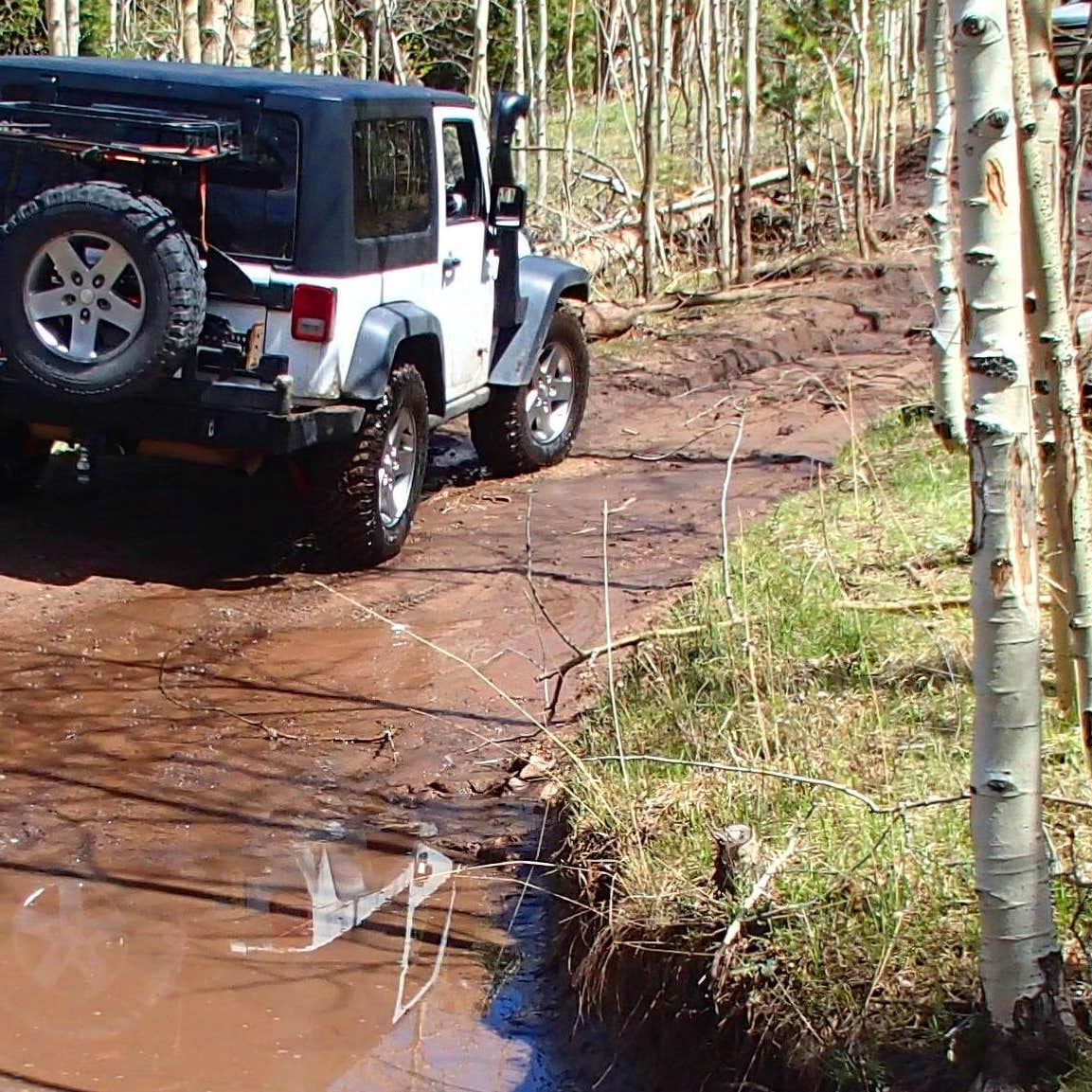
Medano Pass Primitive Road — Great Sand Dunes National Preserve
Medano Pass Primitive Road camping consists of 21 numbered pull-off sites along a rough 22-mile 4WD road that connects the park with the Wet Mountain Valley to the east. Starting about 5 miles from Piñon Flats Campground, these sites are free and first-come, first-served. Each site is marked with a brown post and contains a fire ring and primitive space for 1-2 tents (some can accommodate a small campervan or off-road trailer, but high-clearance 4x4 is required to reach all sites). No services are available -- you'll find only a few vault toilets along the road. Sites are nestled in a mix of grassland and cottonwood groves along Medano Creek upstream of the dunes, with awesome views of the Sangre de Cristo peaks. Popular sites include #4 for its creekside location and #9 which is near Medano Lake trailhead. To camp here, you do not need a permit, but you must have a capable vehicle to handle soft sand, creek crossings (up to 9 crossings), and rocky sections on the pass. In 2025, a free self-issue permit system may be introduced for resource tracking (check park updates). The road is usually open late May through October; in winter/spring it's closed by snow or muddy conditions.
Near-Park & Nearby Campgrounds
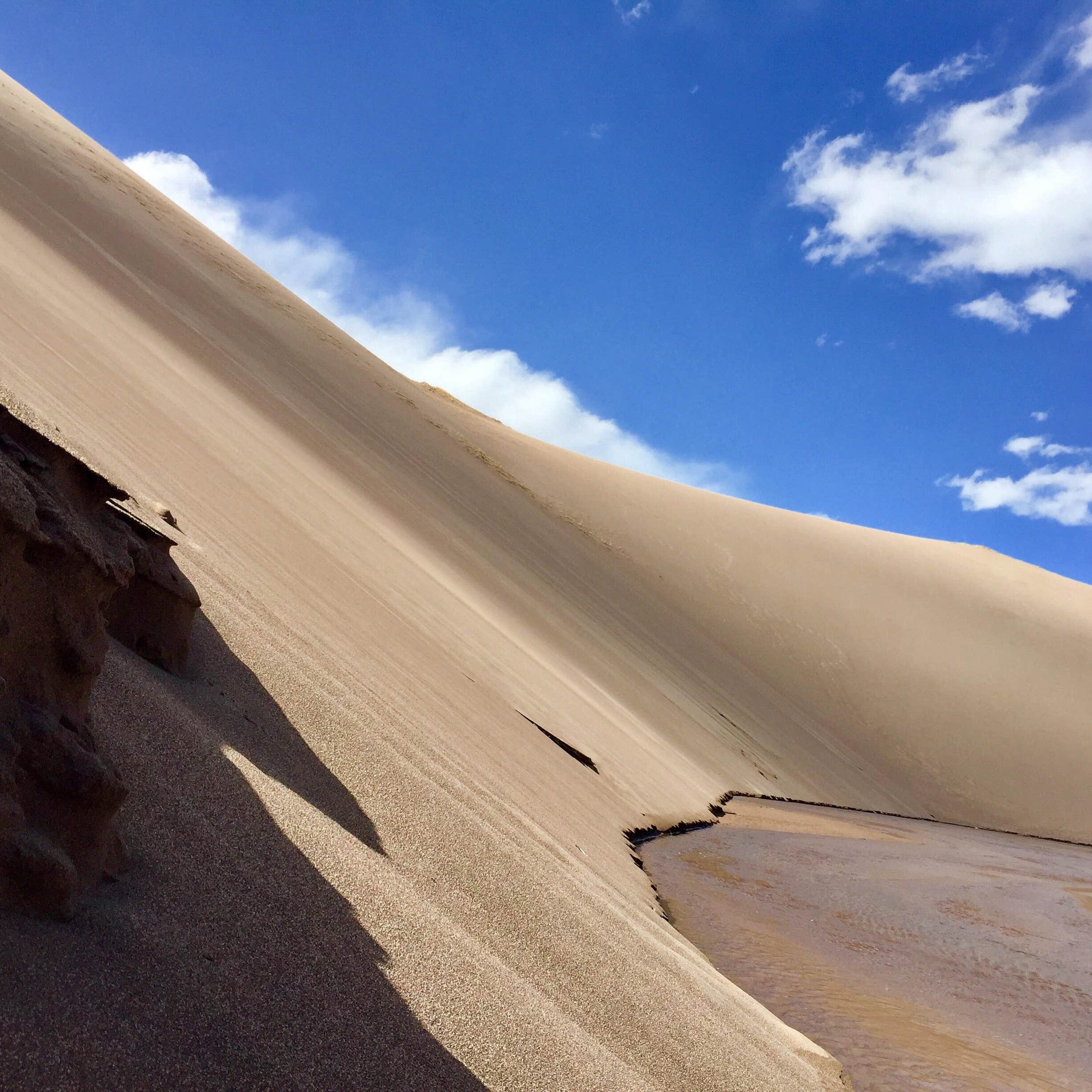
Great Sand Dunes Oasis
Great Sand Dunes Oasis Campground sits just outside the park entrance station and is a popular basecamp for visitors. This privately run campground features 90 sites including RV sites with full hookups, basic tent sites, and a few camping cabins. Amenities are a big draw: there's a convenience store (for ice, firewood, snacks, and those all-important sand sled rentals), a cafe, hot showers, flush toilets, laundry, and even gas pumps nearby. Tent sites are on an open grassy area with picnic tables, while RV sites are gravel pads. Views from the Oasis stretch out toward the dunes and valley -- you'll witness spectacular sunsets painting the dunefield orange. It's open roughly April through October (closed in winter). Reservations are recommended, especially for summer weekends, by calling or booking on their website. Campers note that it can be windy with little natural shade, but the unbeatable convenience (just a 5-minute drive into the national park) and friendly atmosphere make it a top choice for families and RV travelers.
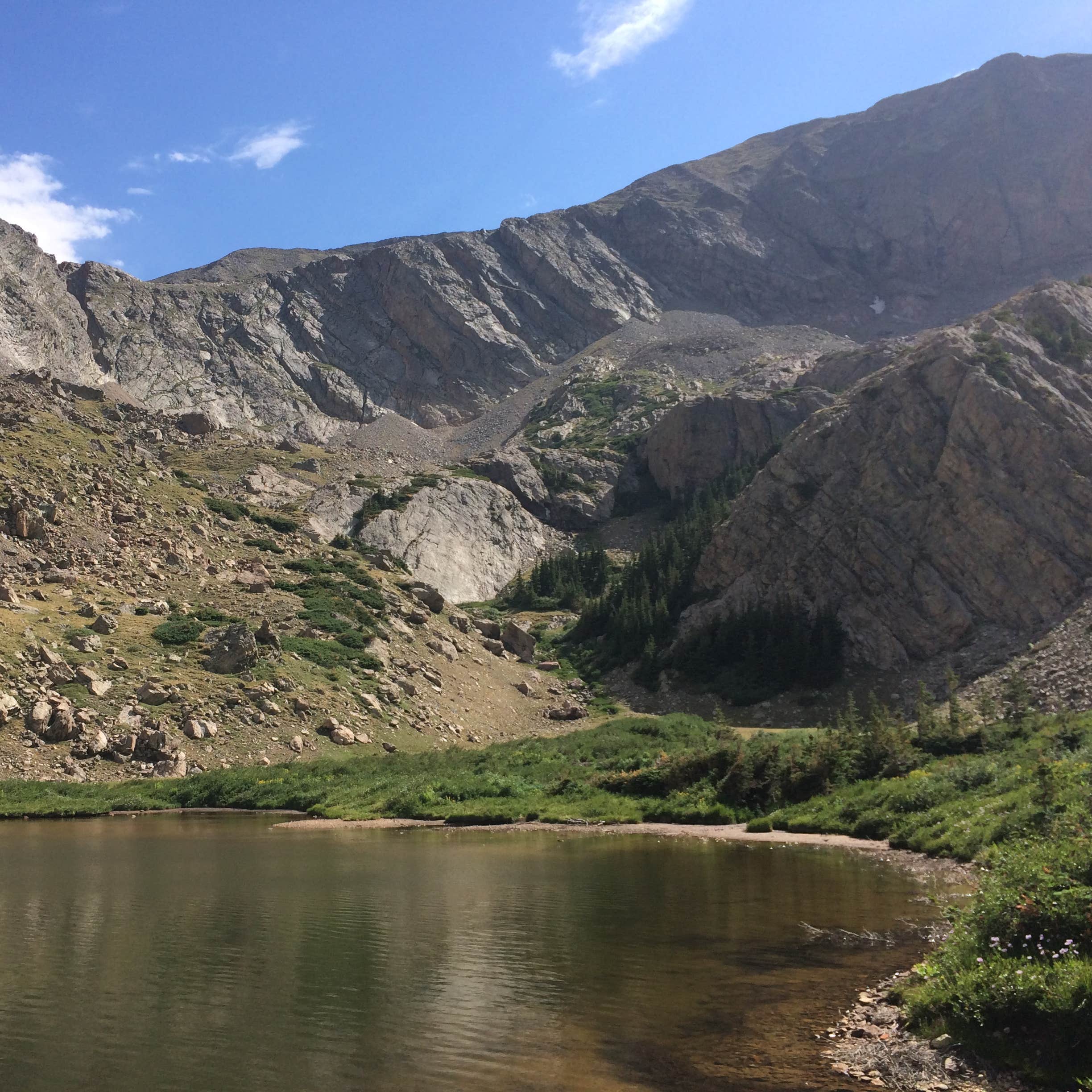
Medano Lake Backpackers Camp — Great Sand Dunes National Preserve
Medano Lake Backpackers Camp is a backcountry camping area in Great Sand Dunes National Preserve, accessible via a strenuous hike. Most backpackers reach it by driving partway up Medano Pass Road (or coming from the east side) and then hiking about 5 miles on trail to Medano Lake, a pristine alpine lake at ~11,000 feet. There are a few flat spots near the lake suitable for tents (no formal sites or facilities). Camping here requires a free backcountry permit just like the dunefield -- it's remote, so you'll need to practice bear-safe food storage (hang or use canisters) and pack out waste. The payoff is camping in a lush cirque of the Sangre de Cristo Mountains, often with the lake all to yourself aside from the resident trout and occasional bighorn sheep. Nights are cold even in summer, and storms can roll in fast at this elevation. Only attempt this trip if you're an experienced backpacker looking for solitude in the high country. It's an incredible add-on for adventurers who want to experience the forests and alpine side of Great Sand Dunes beyond the sand.
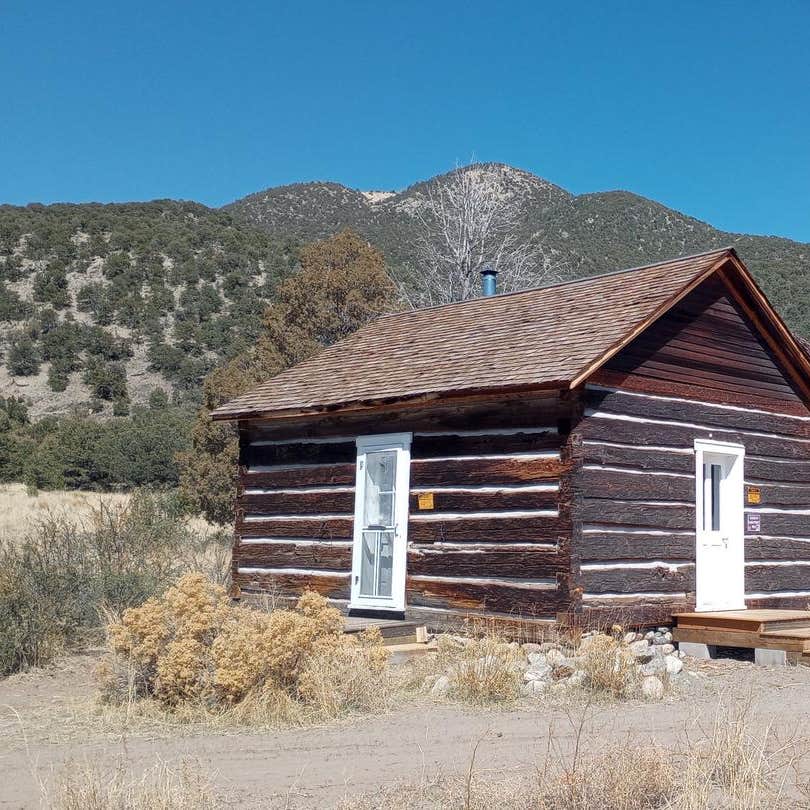
Duncan Cabin — Rio Grande National Forest
Duncan Cabin is a unique historic cabin rental located in the adjacent Rio Grande National Forest, about 11 miles northwest of the park (near the town of Crestone). Accessible by a combination of rough roads and a 4-mile hike (or horseback ride) into a wilderness area, this one-room 1880s log cabin offers a rustic yet memorable lodging experience. The cabin can sleep up to 6 people (two bunk beds and a futon) and comes equipped with a wood stove, basic furniture, a picnic table, and an outhouse. There's no electricity or running water -- you'll need to bring water or filter from a creek 1,500 feet away. Horse-friendly: A corral is located near the cabin, making it popular with horseback campers exploring the Sangre de Cristo wilderness. Reservations are required (it's listed on Recreation.gov) and cost around $40 per night. If you're up for an off-grid adventure, Duncan Cabin places you in a quiet meadow with views of the valley and mountains -- and you're still only a 30-minute drive (plus the hike) from the dunes. It's truly a hidden gem for those seeking a frontier-style camping experience.
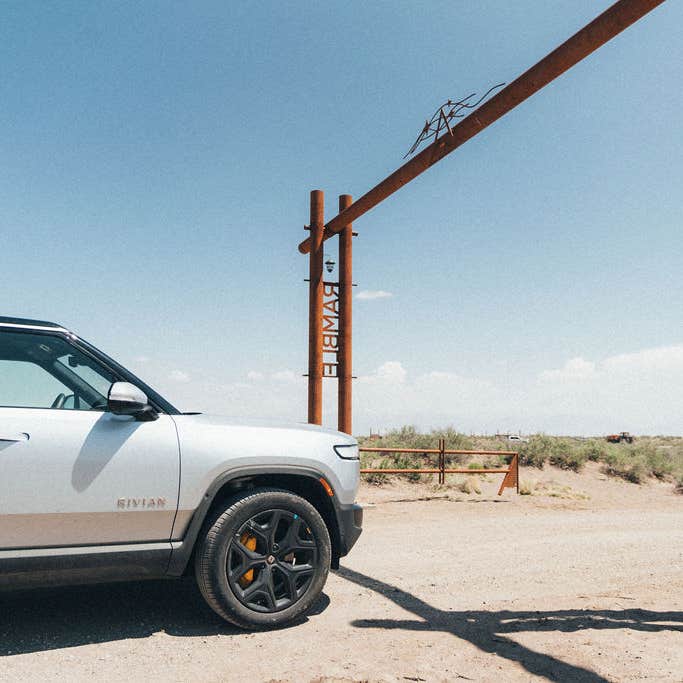
Ramble at Great Sand Dunes National Park
Ramble at Great Sand Dunes is a new private campground and glamping site situated on 640 acres of ranch land about 25 miles southwest of the national park (roughly a 30-40 minute drive). Opened in 2023, Ramble offers a range of camping experiences -- from walk-in tent sites to furnished canvas glamping tents and even converted grain silo 'glampers.' The campground emphasizes sustainability and comfort: you'll find solar-powered amenities, private open-air hot water showers, private bathrooms, a dog run, dishwashing stations, and an on-site camp store. For activities, Ramble has a 3-mile nature trail, mountain bike rentals, a disc golf course, and communal campfire areas. Many sites have panoramic views of the dunefield and Sangre de Cristos in the distance. This is a great option if you want more amenities than the park campgrounds provide, or if Piñon Flats is full -- you can enjoy dark skies and quiet, then drive to the park for adventures during the day. Tent and RV sites require reservations (via their website or campspot), and while prices are higher than basic campgrounds, the comfort and scenery have earned Ramble rave reviews from campers seeking a bit of luxury near the dunes.
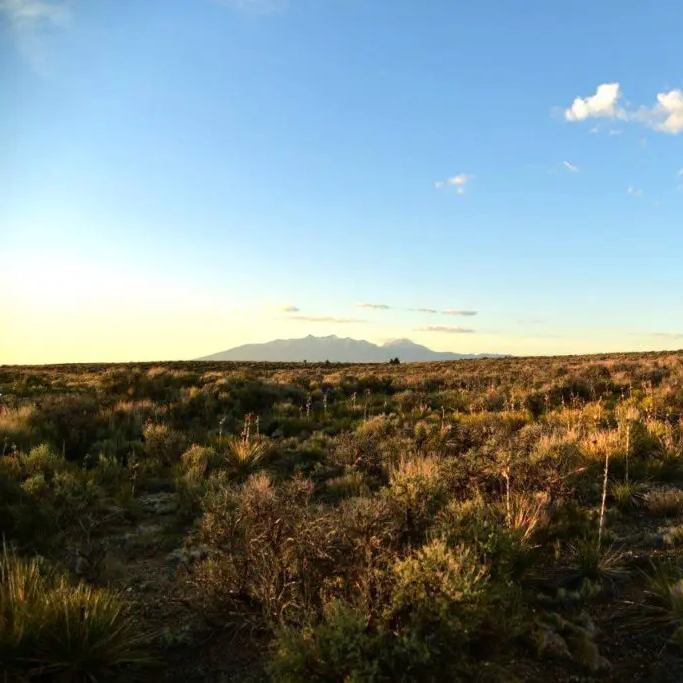
Secluded Star Gazer Campsite Near Great Sand Dunes National Park
Secluded Star Gazer Campsite is a private tent camping spot on a ranch in the San Luis Valley, about 30-40 minutes southeast of Great Sand Dunes. This single-site campground (available to book through The Dyrt's platform) is all about wide-open skies and solitude. The site comes with a large canvas tent on a wooden platform (when available -- check listing details, as of 2025 the canvas tent/yurt might be temporarily unavailable), or you can bring your own tent/RV to set up. There are no hookups or water provided -- it's a pack-in, pack-out off-grid experience. Campers love the uninterrupted 360º view of the night sky; at this low-light location, stargazing is phenomenal. You'll need to be self-sufficient (bring water, propane if you want to use the provided heater, etc.), and keep an eye out for occasional rattlesnakes in summer. A fire pit is available for use when local fire restrictions allow. If you're looking for a quiet, semi-wild place to camp with a front-row seat to the Milky Way, the Star Gazer site delivers. It's also a convenient jumping-off point to explore not only the dunes but also nearby attractions like the UFO Watchtower and San Luis State Wildlife Area.
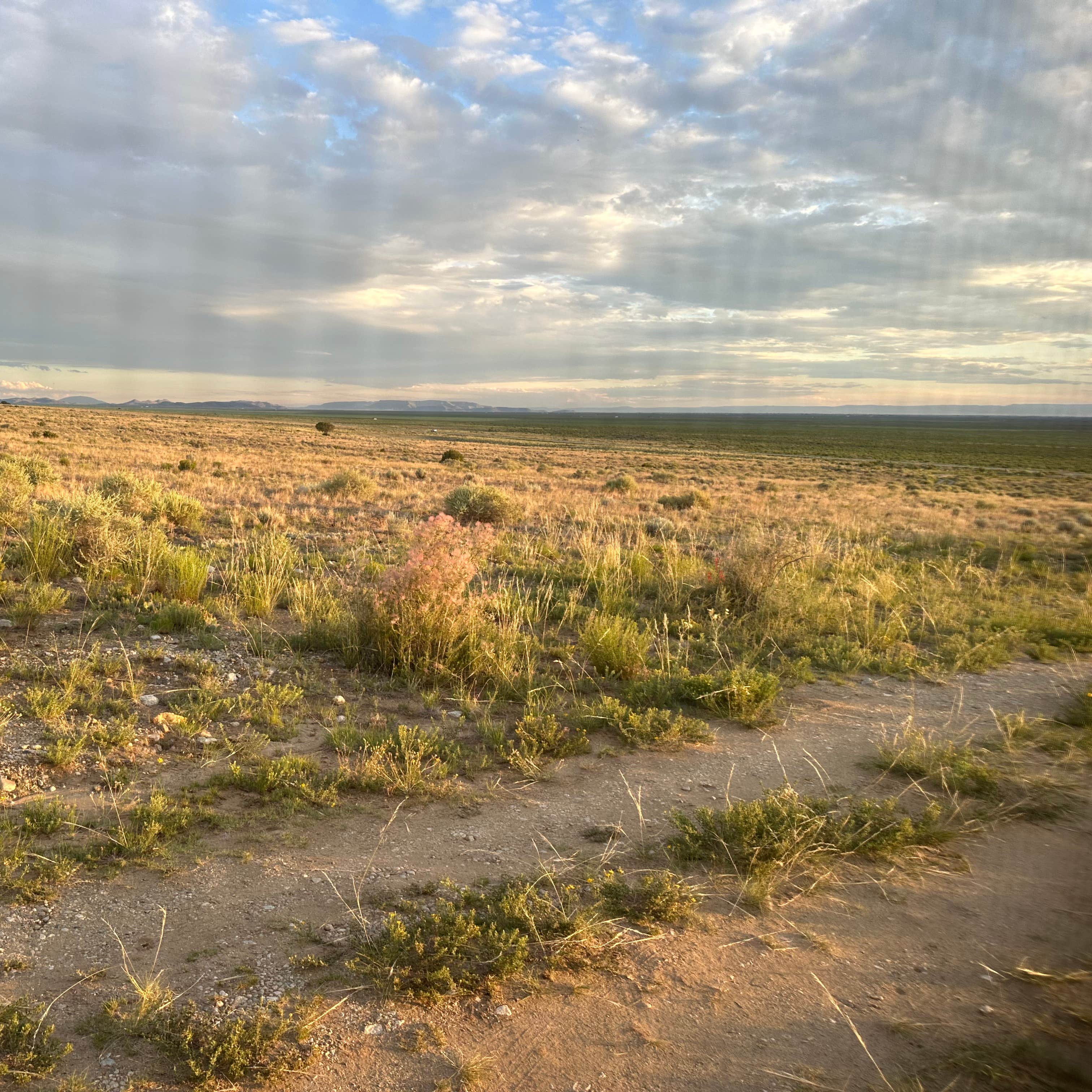
BLM Near Great Sand Dunes Hwy 150
Hwy 150 Dispersed (BLM Near Great Sand Dunes) is a free dispersed camping area on Bureau of Land Management land along the road to the park. Just outside the park boundary on State Highway 150, various pull-outs and dirt tracks on BLM land offer no-fee primitive camping with incredible views. There are no designated sites or amenities (no water, toilets, or tables) -- just choose a previously used spot on the open flats or nestled against low hills. The ground is level in many places, suitable for tents or RVs. Campers report that spots a bit higher up the dirt tracks have the best panorama of the entire dunefield and surrounding mountains. It's first-come, first-served and space is generally plentiful except maybe on busy holiday weekends. You'll often find stone fire rings left by others (use existing rings if fires are allowed, and follow all fire bans). Be prepared for dust and wind, since this area is exposed. Pack out all trash and Leave No Trace so this beloved free camping zone stays open and beautiful. With a good clearance vehicle, you can find some truly secluded spots here. And the location is hard to beat -- you're roughly 5 miles from the park entrance, so you can wake up at dawn and be on the dunes in minutes.
Campground Comparison Table
| Campground | Location & Sites | Cost & Reservations |
|---|---|---|
| Piñon Flats | Inside park (near Visitor Center & dunes) 88 sites (mixed tent/RV) | $20/night Recreation.gov (6 months ahead) |
| Dunefield Backcountry | On dunes (1.5+ mi from road) Unlimited sites (dispersed) | Free (permit required) Permit at Visitor Center |
| Medano Pass Road | Inside preserve (4WD road) 21 primitive sites | Free First-come, self-register |
| Great Sand Dunes Oasis | Outside park (entrance area) 90 sites (tent, RV, cabins) | $20-$40 (sites) Reserve via phone/website |
| Zapata Falls Campground | BLM land 11 mi south 23 sites (tent/small RV) | $11/night Recreation.gov |
| Ramble at GSD | Private 25 mi SW (Mosca) Tent sites, glamping tents | $30-$100 (varies) Reserve on website |
| BLM Dispersed (Hwy 150) | Outside park (valley floor) Unlimited dispersed sites | Free No reservations (public land) |
| Duncan Cabin | Rio Grande NF (Crestone area) 1 cabin (sleeps 6) | $40/night Recreation.gov (cabins) |
Campground Amenities and Best Uses
In-Park Camping: Piñon Flats is ideal for families and first-time visitors who want convenience -- it's right by the dunes and Medano Creek, and offers restrooms, water, and fire rings. This campground gives the classic national park camping feel (with ranger programs in summer) and easy access for sunrise or evening hikes on the sand. Dunefield backcountry camping, on the other hand, is for adventurers seeking total solitude and night sky immersion; go there if you're prepared for backpacking and want a one-of-a-kind experience sleeping on the dunes. Medano Pass Primitive Road campsites cater to those with 4WD vehicles looking for a more rugged, dispersed vibe -- they're great for escaping crowds and sleeping under cottonwoods with the sound of a creek, but you must be self-sufficient and comfortable off-roading.
Private & Nearby Options: The Great Sand Dunes Oasis campground is the top pick for RV campers near Great Sand Dunes National Park needing hookups or anyone who appreciates on-site amenities like showers and a store -- it's the most convenient full-service option, just outside the park. Zapata Falls Campground (BLM) is a hidden gem for tent campers; at 9,000 feet, it's cooler in summer and offers stunning views of the dunes and a short hike to a beautiful waterfall, though you'll brave a bumpy access road. For a step up in comfort, Ramble at Great Sand Dunes provides a glamping-style camping experience near Great Sand Dunes with lots of space and extras -- perfect for couples or families who don't mind the drive in exchange for hot showers and a unique stay. Duncan Cabin is a special-case scenario: best for history buffs or backcountry devotees who want a rustic cabin adventure near the sand dunes (and have the time/gear to reach it).
Free Dispersed Camping: The BLM land along Hwy 150 and other nearby forest roads offer fantastic free camping for the budget-conscious or more spontaneous traveler. These dispersed camping spots near Mosca are best if you're fully self-contained (especially RV or van campers) or a tent camper who doesn't need facilities. They're also pet-friendly and group-friendly, since you won't bother any neighbors if you find a big enough pull-out. Just be sure to bring everything you need and follow Leave No Trace -- these areas have no trash service, and preserving their condition keeps them open for everyone. Campers especially love the BLM spots for star photography and meteor showers, since you can set up far from any lights with the whole sky overhead.
Special Considerations: If you have a large RV, Piñon Flats can accommodate rigs up to about 35 feet in some sites, but anything bigger may need to stay outside the park (the Oasis or Sand Dunes Swimming Pool RV Park in Alamosa are better for big rigs). Horse camping near Great Sand Dunes is limited; the national park doesn't have horse campsites, but riders often use Duncan Cabin's corral or other national forest areas if bringing horses (check out the Zapata Ranch nearby for horse-friendly lodging). Lastly, if you're visiting in winter, your only in-park option is a dunefield backcountry permit (extreme conditions) -- otherwise plan on camping at lower elevations outside the park or find a cabin/hotel.
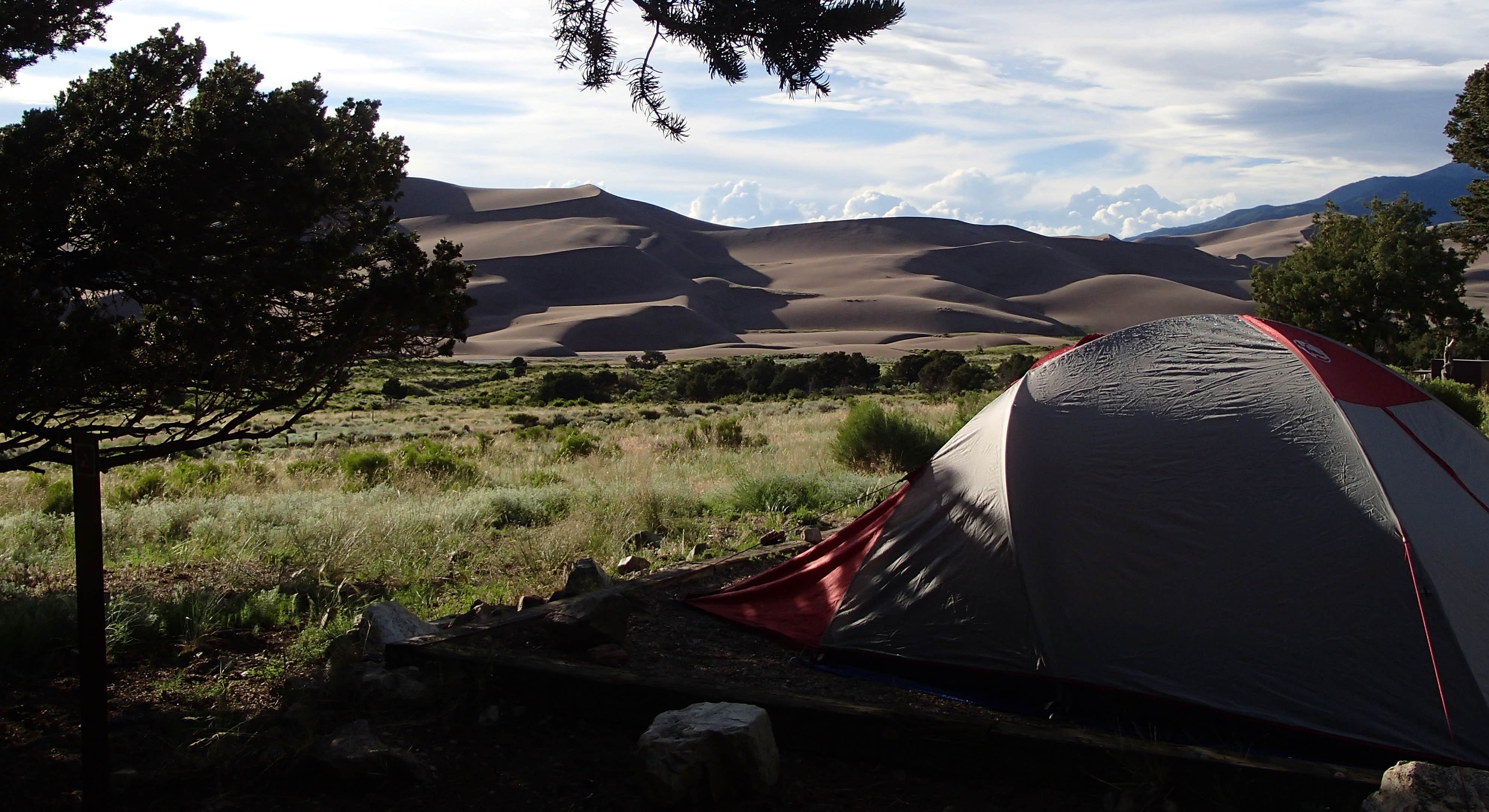
Planning Your Great Sand Dunes Camping Trip 
When to Visit
| Season | Temperatures | Camping Conditions |
|---|---|---|
| Spring (March-May) | Days: 50-70°F (wide swings) Nights: 20-35°F | Volatile weather: calm sunny mornings vs. very windy afternoons Medano Creek starts flowing by mid/late spring (May) Piñon Flats opens April 1; higher elevation sites may be snow-covered |
| Summer (June-August) | Days: 75-80°F (sand surface up to 150°F) Nights: 40-50°F | All campgrounds open and accessible High demand season -- reservations essential Afternoon thunderstorms common (lightning risk on dunes) |
| Fall (September-October) | Days: 60-75°F Nights: 25-40°F | Generally sunny, mild days and cold nights Piñon Flats closes late October; early snow possible at higher elevations Great time for fewer crowds and golden aspens in mountains (mid-late Sept.) |
| Winter (November-Feb) | Days: 20-45°F Nights: -5-15°F | Piñon Flats closed; Medano Pass road closed by snow Backcountry permit camping only inside park (dune or winter backpacking) Very quiet -- expect solitude and harsh cold conditions |
Spring (March-May):
Early spring can still feel like winter at Great Sand Dunes. March and April often bring snow (these are actually the snowiest months on average) and very strong winds that can kick up sand storms in the afternoons. Daytime highs might reach the 60s°F on a nice day, or stay in the 30s°F with a cold front -- it's unpredictable. Nights frequently drop below freezing. By May, conditions moderate: highs in the 70s are possible and Medano Creek usually begins flowing at the dune base, attracting families to splash in the cold, shallow water. Spring campers should be ready for anything: gorgeous calm mornings, afternoon gusts, and even late snow flurries. If you're camping in spring, tie your tent down securely (wind can flatten poorly staked tents), and pack layers from T-shirts to insulated jackets. The benefit of spring? Smaller crowds (at least until Memorial Day) and the chance to see the dunes with patches of snow or seasonal wildflowers starting to pop up in the grasslands.
Summer (June-August):
Summer is peak season, and for good reason -- the weather is generally warm and sunny. Highs typically range from the mid-70s to low 80s°F, which feels pleasant in the dry air. However, the sand surface becomes extremely hot under direct sun; by afternoon, sand temperatures can burn your feet (150°F+), so plan your dune treks for early morning or evening. Nights are comfortable but cool (40s°F), so you'll still want that hoodie or a 20°-rated sleeping bag. All facilities are open: Piñon Flats is fully booked most nights, Medano 4x4 campsites fill up on weekends, and nearby campgrounds are bustling. Reservations for any reservable campground should be made as early as possible (6 months ahead for Piñon Flats means booking in winter for a June trip!). Another thing to plan for is the monsoon -- late July and August afternoons often see sudden thunderstorms rolling over the mountains. These storms can bring lightning, heavy rain, and wind. If you hear thunder while on the dunes, get off the high ridges immediately and return to low ground. Many campers spend middays enjoying Medano Creek (if it's still running in June/July) or taking a siesta in the shade, then venture back out when clouds cool the sand. Despite the crowds, summer offers the fullest park experience: ranger programs, longer days to explore, and the chance to enjoy water, sand, and mountains all in one trip.
Fall (September-October):
Autumn is a favorite time for many veteran Great Sand Dunes campers. After Labor Day, the massive summer crowds taper off, especially on weekdays. The weather in September is often superb: crisp, blue-sky days in the 60s-70s°F and nights in the 30s°F. Aspens and cottonwoods in the surrounding mountains turn gold by mid to late September, adding brilliant color to your hikes (consider a drive up Medano Pass or a hike to Mosca Pass to see fall foliage). Wildlife like elk become more active in the valleys during the fall rut. October brings colder changes -- by mid-October, Piñon Flats Campground closes for the season and you need to be prepared for freezing nights regularly. It's not uncommon to get a light snow on the dunes in October, creating a stunning contrast of white snow and tan sand (and if you're lucky enough to camp right after a snowfall, the landscape will be unforgettable). During fall, dress in layers -- you might be in a T-shirt at lunchtime but bundling in a down jacket by evening. Fall campers have the advantage of quiet campfires and brilliant stars without the summer throngs, but keep in mind services start becoming limited: the Oasis store/cafe usually closes in October and the Medano road might become impassable with early snow toward the end of fall.
Winter (November-February):
Only the hardiest campers tackle Great Sand Dunes in winter, but it is allowed via backcountry permit. Winters here are cold and dry. Daytime highs can occasionally reach the 40s°F or higher on sunny days, but blizzards and frigid wind are possible. Nights routinely fall below 0°F in December and January. There are some upsides: the park is extremely peaceful, and a dusting of snow on the dunes under a full moon is magical. Photographers and experienced winter trekkers sometimes snowshoe out onto the frozen dunes to camp -- but this is a serious endeavor requiring winter camping gear, high-calorie food, and expert prep. More commonly, visitors in winter will stay in a heated cabin or hotel in Alamosa (or rent Duncan Cabin for a "winter cabin camping" experience) and come into the park for day trips. Roads: the scenic drive to Piñon Flats is plowed, but Medano Pass 4WD road is closed by snow or ice. If you do winter-camp on the dunes, you must self-register for a permit (the visitor center may have limited hours), carry a GPS or be skilled with a map and compass as your footprints can disappear with wind or snowfall, and have a plan for extreme windchill. On the plus side -- no bugs, no bears (they're hibernating), and you might have a starry midnight dune all to yourself. Always check the park's alerts for any winter closures or advisories before heading out.
Great Sand Dunes Reservation Systems Explained
Securing a campsite at Great Sand Dunes varies from "book it months in advance" to "just roll up and pick a spot," depending on which option you choose. Here's how to navigate the different systems:
Piñon Flats Campground (Inside Park): Reservations are required in peak season. All 88 sites are reservable on Recreation.gov, with a 6-month rolling window. This means if you want a mid-June reservation, be online in mid-December. Mark your calendar and be ready at 8 AM Mountain Time when sites open -- summer weekends literally can book out within minutes. There's no first-come, first-served availability in summer. In shoulder seasons (April, early May, late Sept.), any unreserved sites may be used first-come, but it's risky to rely on that. Pro tip: If you miss out, check Recreation.gov in the week before your trip; last-minute cancellations do happen, and you might snag a site by refreshing frequently.
Backcountry Permits (Dunefield & Other Wilderness): These are free but limited. You must obtain them in person at the visitor center. Dunefield permits are typically capped at about 20 parties per night to prevent overcrowding on the dunes. They're issued on a same-day or day-prior basis -- essentially first-come, first-served at the desk. It's rare for them to "sell out" except possibly holiday weekends when lots of scouts or groups show up. Still, it's wise to get to the visitor center early in the day to secure your permit, especially if you have a larger group or specific date. You'll be shown a brief Leave No Trace video and required to follow strict rules (like no camping on vegetation, distance from water sources, etc.). For other backcountry zones like the Sand Creek or Indian Grove areas in the preserve, similar permits are needed. Call ahead to ask about current procedures in 2025 -- the park was considering moving some permit requests to Recreation.gov or email, but as of now it's walk-in.
Medano Pass Primitive Road Sites: No formal reservations or permits required (as of 2025). These 21 sites are first-come. What you should do is stop at the little self-registration kiosk near the start of the road (after Castle Creek Picnic Area) and fill out a free permit tag to hang in your car/campsite -- this just lets rangers know you're out there and helps them track usage. In popular months (June-August), the sites closest to the dunes (sites 0-3, for example) often fill by early afternoon. If you drive in and find everything taken, you have a few options: one, continue over Medano Pass and look for dispersed camping in the national forest on the east side; or two, head back out and camp on BLM land or Oasis as a fallback. Some people "cruise" the road around checkout time (11 AM-1 PM) to snag a site as others leave. Also, weekdays see much lighter use than weekends here.
Private Campgrounds (Oasis, Ramble, etc.): These each have their own system. Great Sand Dunes Oasis takes phone reservations and some online requests. For summer, definitely call well ahead for RV sites or cabins; tent sites are often available last-minute, but it doesn't hurt to book those too, especially if you want to be near friends. Oasis also has overflow dry-camping for self-contained RVs if everything is full. Ramble at Great Sand Dunes uses an online reservation platform (and was even featured on CampSpot and Hipcamp). Summer weekends can sell out their premium glamping tents weeks in advance. Since Ramble offers refunds up to a certain date, watch their booking page for any newly opened spots as your trip nears. Zapata Falls Campground now requires reservations via Recreation.gov -- a change from its old first-come system -- so you'll need to book one of its 23 sites in advance (2 week rolling window) and then drive up that rough road with a confirmation in hand.
First-Come, First-Served Strategy: If you prefer spontaneity, aim for dispersed camping or less busy times. BLM dispersed spots near Great Sand Dunes around the valley do not require any booking -- just have a backup in case your first choice spot is occupied. During mid-week or outside of June-July, you can often find something at Piñon Flats due to cancellations (check at the campground kiosk or visitor center in late afternoon for any same-day openings). The park also has an unofficial practice: if you arrive after hours and have nowhere to go, you can overnight in your vehicle at the Dunes parking lot or Amphitheater parking as a last resort with an active park entrance pass -- it's not a guaranteed policy, but rangers have been known to direct late arrivals there in emergencies (no tents, just car-camp). Don't count on this, but it's good to know it's possible in a pinch.
Campground Costs and Budgeting
| Campground Type | Nightly Cost | Key Features |
|---|---|---|
| National Park Campground | $20 (standard site) | Piñon Flats: includes tent/RV site, picnic table, fire ring, access to water & restrooms (no showers or hookups) |
| Primitive Backcountry | Free | Dunefield & Medano Road sites: no fee to camp (park entrance fee still required). No facilities; bring all gear |
| Private Campground | $20-$45 (sites) | Examples: Oasis tent site ~$20, RV full hookup ~$40. Includes access to showers, store, etc. Cabins or glamping extra $ |
| Cabin Rental | $40-$150 | Duncan Cabin ~$40; Private cabins (Oasis or nearby) $100+. Higher cost but provides shelter from weather |
Additional Fees and Budget Tips
Park Entrance Fees: Remember that camping fees don't include park entry. As of 2025, the Great Sand Dunes entrance fee is $25 per vehicle (good for 7 days). If you have an America the Beautiful National Parks annual pass ($80), that covers it. Otherwise, budget that $25 in. If you're arriving after hours when the entrance booth is closed, you are expected to pay at the self-pay station or the next day at the visitor center.
Firewood and Supplies: You cannot gather firewood in the park, so you'll likely need to buy it. The Oasis store sells firewood bundles around $7-$9 each. A campfire each night can add up -- perhaps plan to have a fire just one special night or collect dead-and-down wood outside the park on forest land if allowed (always observe local fire regulations). The Oasis also sells ice (about $3 a bag), basic groceries, and sandboard rentals (~$20/day), which can be very convenient but slightly pricier than in town. In Alamosa (35 miles away) you'll find supermarkets for cheaper groceries and even a Walmart for gear or food restock.
Free Camping Options: To truly camp for free, dispersed BLM camping near Great Sand Dunes and national forest camping is your go-to. Not only is it $0, but there are no permit fees. The only "cost" is the extra effort to be self-sufficient (bringing your own water, etc.). If you mix a few nights of free dispersed camping with a night at a paid campground (for shower and supply purposes), it can stretch a budget while still giving you some comforts periodically.
Essential Gear for Great Sand Dunes Camping
Packing smart for Great Sand Dunes will make the difference between an enjoyable camping trip and a potentially uncomfortable one. The environment ranges from hot, exposed sand dunes to cool, shaded alpine forests -- sometimes all in one day if you explore the whole park.
Shelter and Sleeping:
- Sturdy Tent with Full Rainfly: Afternoon winds can be extremely strong, so a robust tent that can be staked down securely is a must
- Warm Sleeping Bags: Even in summer, nighttime temps can drop to the low 40s°F. A sleeping bag rated around 20-30°F is a good all-around choice
- Sleeping Pad with Insulation: An insulated sleeping pad (R-value 3 or above) will keep you warmer at night
Clothing and Sun Protection:
- Layered Clothing System: Plan for temperature swings of 40+ degrees in a day
- Wind Protection: A good windbreaker or lightweight shell jacket is important
- Sun Hat and Sunglasses: The sun at 8,000 feet is intense
- Footwear: Bring comfortable hiking boots for trails and thick socks with sandals for midday on sand
Camping Kitchen:
- Water Containers: Plan on at least 1 gallon per person per day for drinking and basic washing
- Cooler with Ice: Keep your cooler in the shade or wrapped in a reflective blanket
- Camp Stove and Fuel: A gas stove is more reliable for cooking, given winds and frequent fire bans
- Bear-Resistant Food Storage: Piñon Flats provides bear lockers at sites -- use them for all food, trash, toiletries
Sand-Specific Gear:
- Sand Sled or Board: Renting one is easiest (designs from vendors have slick bases that work well on sand)
- Small Daypack: You'll want a backpack for venturing onto the dunes
- Tarp or Ground Sheet: Lay it out at your dunefield camp to create a sand-free zone
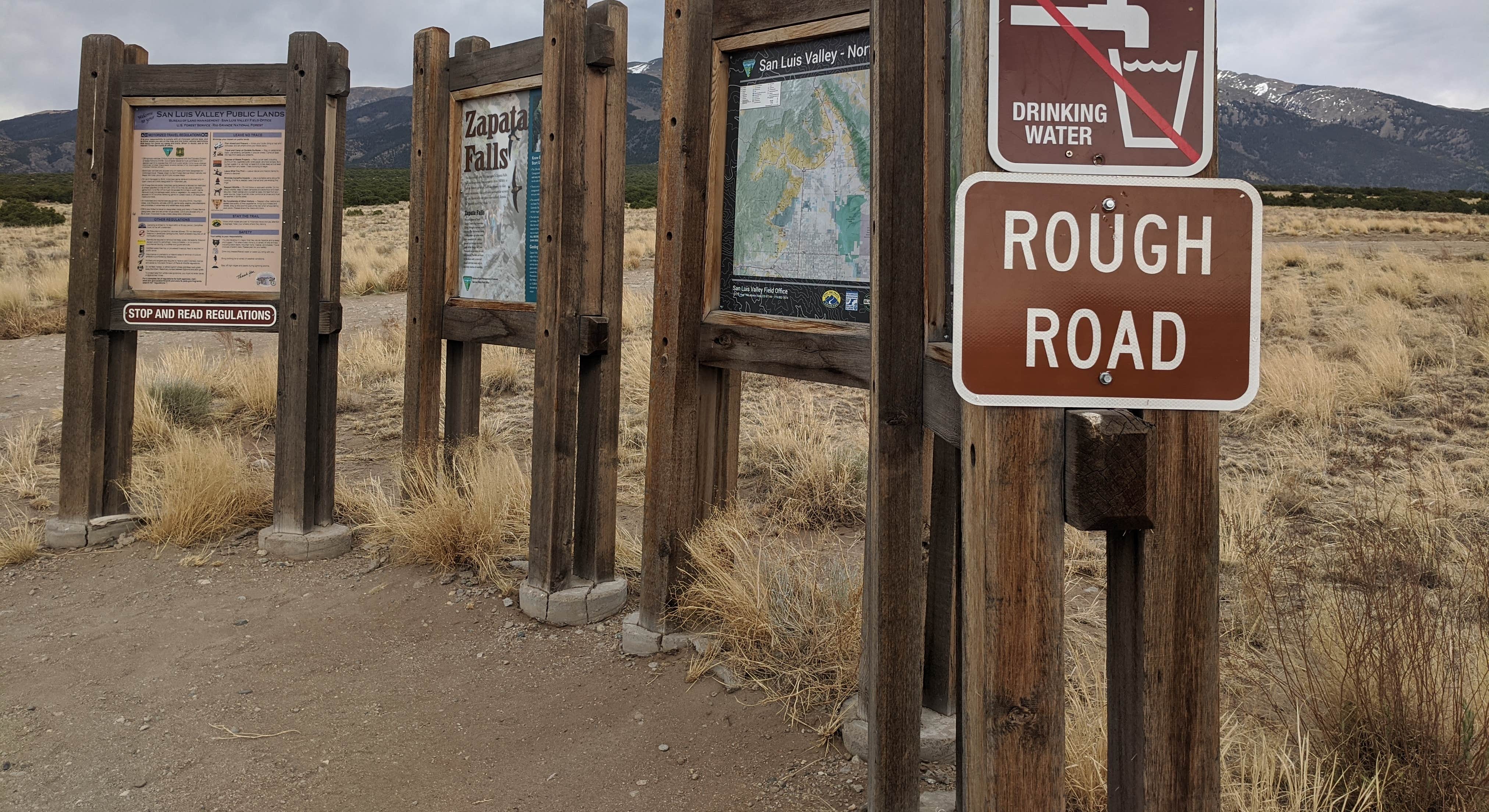 Photo by Lena M
Photo by Lena M
Wildlife Safety and Park Regulations 
Black Bear Safety in Great Sand Dunes
Great Sand Dunes has a healthy black bear population, especially in the wooded mountain slopes and riparian areas of the preserve. The key to coexisting is preventing bears from getting any human food.
Food Storage Requirements:
- Use the Bear Boxes: At Piñon Flats, every campsite has a shared bear box or one nearby -- absolutely use them
- Put all food, coolers (even if empty), trash, toiletries (yes, toothpaste attracts bears), and cooking gear inside whenever you're not actively using them
- If camping along Medano Pass road or dispersed, store food in a hard-sided vehicle (lock the doors) or use a certified bear-resistant container
- Never leave coolers or food out while you go off to the dunes for sunset
Bear Encounters:
- If you encounter a bear, do not run
- For black bears, stand tall, make noise, and slowly back away if the bear hasn't noticed you
- If it's closer and does notice, talk firmly and loudly, and give it space to leave
- Report any bear incidents to rangers so they can manage that animal before something escalates
Park Regulations and Etiquette
| Regulation Category | Specific Rules | Penalties |
|---|---|---|
| Campfires | Only in established rings or grills Never on sand or in backcountry Must be attended at all times | Citations and fines Possible campground eviction |
| Food Storage | All food in bear boxes or vehicles No food in tents Clean tables after use | Fines starting at $125 Possible eviction |
| Quiet Hours | 10:00 PM to 6:00 AM Generators off during quiet hours | Warnings and possible eviction |
Additional Wildlife and Safety Considerations
Rattlesnakes: Prairie rattlesnakes are found in the San Luis Valley, though they're more common in grasslands and shrub areas at lower elevations. Watch where you step, especially around brush or at night. Keep a flashlight handy when walking after dark.
Elk and Deer: Mule deer are common in the campground; you'll often see them browsing in early morning. They seem tame but remember they are wild -- never feed or try to approach. Give elk at least 25 yards distance.
Campfire Safety: Few camping moments beat sitting around a campfire under the stars -- but in this environment, fire safety is paramount. Fires only in established rings at Piñon Flats, use the metal fire grate provided at your site. In the national park backcountry (dunes, etc.), fires are not allowed at all. Don't scavenge wood from the park (even dead branches). When you're done with your fire, drown it thoroughly.
Beyond the Campground: Activities and Exploration 
Day Trips from Great Sand Dunes Campgrounds
From Piñon Flats Campground:
Being in the heart of the park, Piñon Flats campers have the luxury of quick access to the main dune field. A popular "day trip" is simply hiking to the top of High Dune, which is about 700 feet tall (~2.5 miles round-trip from the main parking lot). Another must-do from this area in late spring/early summer is Medano Creek: walk 5-10 minutes from the campground to the creek bed and spend the afternoon splashing, building sand castles, or floating tiny pool floats. The Dunes Overlook Trail (4 miles round-trip) starts near the Amphitheater and gives a less crowded view from a grassland hill -- great for sunset. If you want to venture a bit further, drive 5 minutes to the Mosca Pass Trailhead near the visitor center; this trail goes 3.5 miles (one-way) up a pretty forested canyon to a low pass in the Sangre de Cristo Mountains.
From Medano Pass Primitive Road:
If you're camping along the Medano Pass road, one obvious day trip is simply to continue the drive! The entire Medano Pass 4WD Road takes you from the dunes (western end) up and over the Sangre de Cristos to Highway 69 on the east side. Another fantastic outing from these sites is Medano Lake Trail: if you're near campsite #7 or #8, the Medano Lake trailhead is just up the road. This challenging hike (about 7 miles round-trip, 2000+ ft gain) takes you through dense forest to a gorgeous alpine lake at tree line.
From Outside the Park:
If you're based at the Oasis or nearby, you're conveniently located to also explore Zapata Falls. This is a terrific half-day trip: drive 11 miles south on Hwy 150 and bump up the 3.5-mile gravel road to the Zapata Falls trailhead. A short but rocky 0.5-mile hike leads to a 30-foot cascading waterfall hidden in a rock crevice. Near Zapata Falls road entrance is the UFO Watchtower (a quirky roadside attraction/campground with a platform for supposed alien viewing -- fun for an offbeat stop and only $2 to climb the tower).
Top Hiking Trails Near Campgrounds
| Trail Name | Difficulty & Distance | Key Features |
|---|---|---|
| High Dune on First Ridge | Strenuous ~2.5 miles RT | Tallest dune on main ridge (~700 ft climb), 360° views, signature dunes hike |
| Star Dune | Strenuous ~6-8 miles RT | Highest dune in North America (755 ft), requires cross-dunes trek, unparalleled vistas |
| Mosca Pass Trail | Moderate 7 miles RT | Canyon trail through forest to mountain pass, lush vegetation, valley views |
| Zapata Falls Trail | Easy-Moderate 1 mile RT | Short hike to dramatic waterfall, cool respite on hot days, panoramic dune views |
| Medano Lake Trail | Strenuous 7 miles RT | High-altitude hike to alpine lake at 11,500', wildflowers, possible wildlife sightings |
| Dunes Overlook Trail | Moderate 4-5 miles RT | Gentle climb to overlook, less crowded, likely to see mule deer |
Water Activities in Great Sand Dunes
Despite being known for sand, Great Sand Dunes offers some refreshing water activities especially in late spring and early summer:
Medano Creek: When in season (generally May and June, sometimes early July), Medano Creek is the star attraction. It flows along the base of the dunes near the main parking area, creating inches-deep pools and rivulets perfect for wading. One of the creek's cool features is "surge flow" -- waves of water that come every 20 seconds or so due to sand damming up then bursting through.
Sand Dunes Swimming Pool (Hooper Pool): Located north of Alamosa (about 30 miles from the park, in Hooper), this is a developed large pool fed by hot springs and kept at pleasant swimming temperature. If the kids need a break from sand or the weather turns bad at the dunes, a few hours here can be a nice change.
Zapata Falls: Not exactly for swimming, but you will get wet. To see the falls, you must walk upstream in Zapata Creek about 100 yards into a rocky slot. In late summer the flow is low and it's easy to navigate (water ankle to knee deep).
The Dyrt Community Insights 
Ranger Recommendations
The Dyrt Rangers - experienced campers who document and review camping areas - offer these insider tips for Great Sand Dunes:
Best Sites at Piñon Flats:
"Try to grab a site on the outside of Loop 2 or 3 for more privacy and dune views," suggests one The Dyrt Ranger. Indeed, the outer loop sites (like site 20 or 40) back up to open dunes/grass and give you a more unobstructed view of the sands and mountains. Rangers also note that Loop 1 is closest to the amphitheater and trail to the dunes, convenient for families but a bit more traffic, whereas Loop 3 is furthest and quietest.
Hidden Gem Campground:
Many in the community praise Zapata Falls Campground for its stunning overlook of the dunes. "We loved camping up at Zapata. It's primitive, but the sunset views and the sound of the creek were worth the rough drive," says one camper. This BLM campground often has last-minute availability when the park is full, making it a great fallback.
Free Camping Favorite:
The Dyrt users consistently rave about the BLM dispersed sites off Hwy 150. "If you get a spot here, you're literally 5 minutes from the dunes while camping for $0 -- hard to beat!" one reviewer wrote. Another noted the importance of driving further off the highway onto the dirt tracks to find more secluded spots.
Top-Rated Great Dunes NP Campsites from The Dyrt Community
| Category | Top Pick & Rating | Key Highlights |
|---|---|---|
| Highest-Rated In-Park | Backcountry Dunefield 5.0/5 stars | Solitude, incredible night sky, novelty of camping on dunes |
| Favorite Private | Great Sand Dunes Oasis 4.5/5 stars | Convenience, clean bathrooms, hot showers, friendly staff |
| Best Free Spot | BLM Dispersed off Hwy 150 4.7/5 stars | Easy access, beautiful scenery, quiet, unbeatable value |
| Most Unique Stay | Duncan Cabin 4.5/5 stars | Seclusion, "stepping back in time" feel, worth the difficult access |
Community Insights and Recommendations
Don't Skip the Creek: Multiple reviewers insisted that if you go in late spring, spending time at Medano Creek is a must-do: "We almost skipped it thinking it was just a little stream -- so glad we didn't. It was my kids' favorite part!" wrote one camper.
Sunset & Sunrise are Magic: Many campers recount the dramatic lighting at dusk and dawn. One Ranger recommendation: "Hike out 15 minutes onto the dunes for sunset -- you'll leave most people behind near the parking area and get an incredible light show, then use a headlamp to get back."
Clothing & Comfort: A funny but useful tidbit: "Bring a cheap rug or welcome mat for your tent." Sand gets everywhere, and having a little doormat to wipe or sit on while brushing off feet before entering the tent can keep your sleeping area much cleaner, as one camper suggested.
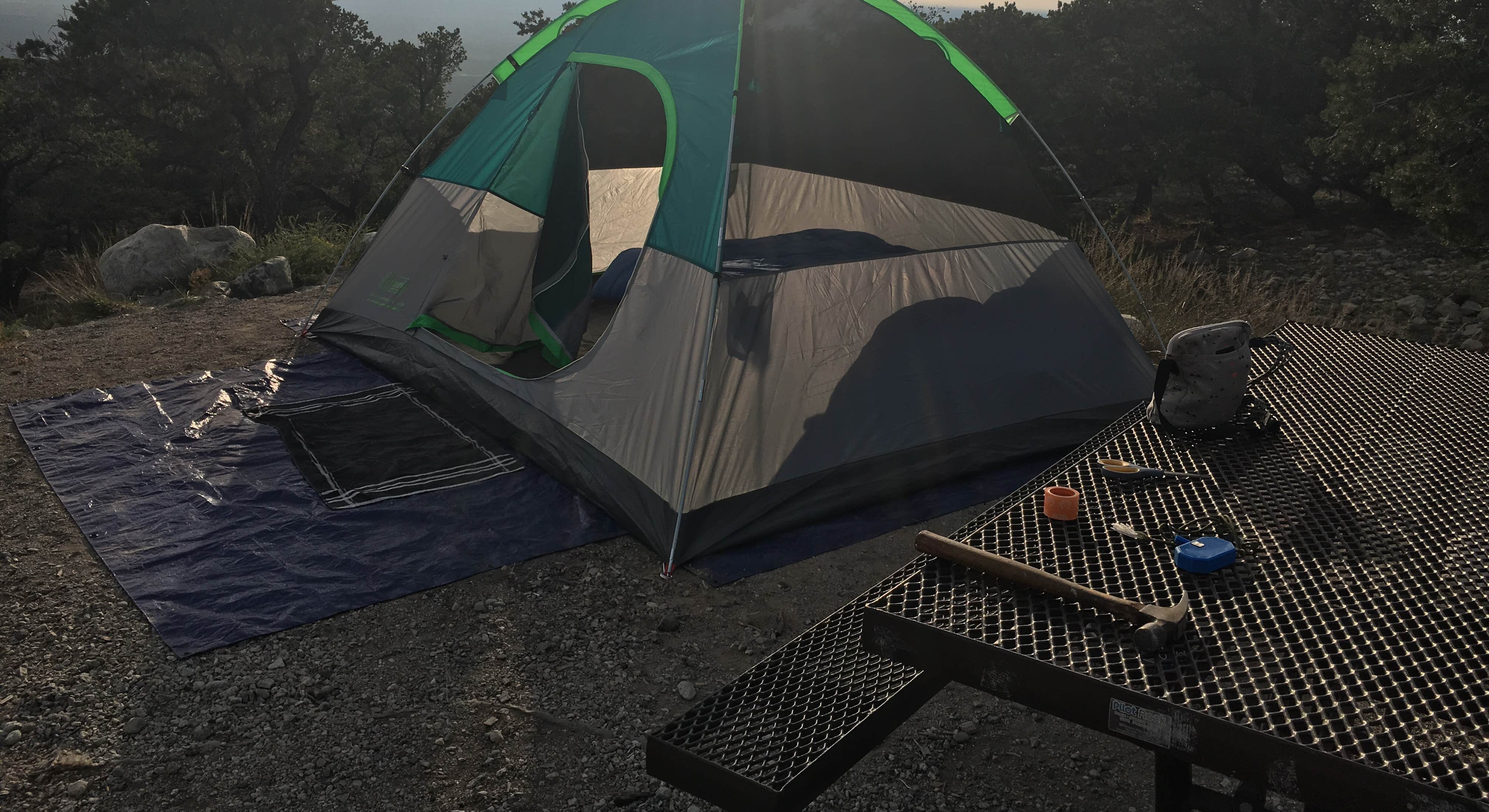 Photo by Paul R
Photo by Paul R
Responsible Camping Practices 
Leave No Trace in Great Sand Dunes
Preserving the beauty and wildness of Great Sand Dunes National Park & Preserve is everyone's responsibility. When camping here (or anywhere, really), following Leave No Trace principles and park regulations ensures that future generations will enjoy the same pristine dunes and clear streams.
Pack It In, Pack It Out:
Whatever you bring into the park or your campsite, plan to take it back out with you. This includes all trash (even those tiny corner wrappers from your granola bar), leftover food, and gear. Wind can scatter items quickly -- secure your garbage. The park provides dumpsters near Piñon Flats and the visitor center; use them. If you're camping in Great Sand Dunes backcountry or dispersed camping, carry a garbage bag in your pack and double-bag anything that could leak.
Respect Wildlife:
Observe animals from a distance and never feed them. Feeding wildlife (intentionally or accidentally through leaving food out) is harmful -- animals can become dependent or aggressive, and human food can make them sick. If a wild critter comes near, enjoy the encounter quietly and without interaction. Use zoom on your camera instead of moving closer.
Leave It As You Find It:
Sand dunes might tempt you to carve a big message or build elaborate sand structures. But large alterations can take a long time to heal -- and in wilderness areas of the dunefield, it's not appropriate. Write memories in your journal, not huge letters on the sand. The park prohibits collecting any natural or cultural objects: that means no taking home sand (besides what's inevitably in your shoes!), rocks, plants, or artifacts you might stumble on.
Campfire Ethics:
Use established fire rings -- do not create new fire pits, especially not on the dunes or in sensitive soil. Burn only wood (and paper trash if you must, though it's better packed out). Never burn glass, aluminum, or foil -- they won't fully melt or burn, leaving hazardous remnants.
Sanitation and Water:
When restroom facilities are available (campground, visitor center), use them. If you're in the backcountry or far from a toilet, proper human waste disposal is critical. On the dunes, digging a cathole is difficult, so wag bags (portable toilet bags) are strongly recommended for backcountry dune camping.
Frequently Asked Questions 
When is the best time of year to camp at Great Sand Dunes? It depends on what you're looking for. Late spring (May) is fantastic if you want to experience Medano Creek at its peak flow -- great for kids and a beach-like vibe. Summer (June-August) offers the warmest temperatures and all facilities/services open, but also the biggest crowds and afternoon thunderstorms. Fall (September) is a sweet spot: fewer people, generally stable weather, and cool nights -- ideal for hiking and photography. Winter is for the hardy -- very quiet but you'll need to bundle up. For most, late spring and early fall probably offer the most enjoyable camping conditions overall.
How do I get a dunefield backcountry permit? Backcountry permits for the dunefield are issued for free at the Visitor Center on a first-come, first-served basis. In person only -- no reservations. There is a nightly quota (around 20 groups per night). On most days, you can walk in the morning of or day before and get a permit without issue. Rangers will give you a briefing on rules, have you watch a short video, and then you'll fill out a tag to carry.
Can I camp anywhere on the dunes? Not anywhere -- there are guidelines and restrictions. In the main dunefield, backcountry camping is allowed in the designated primitive backpacking zones once you have that permit. You choose a spot at least 1.5 miles out and out of sight of the road. Elsewhere in the park, Piñon Flats is the only established campground. Along the Medano Pass 4WD road, camping is only allowed at the 21 marked sites.
How cold does it get at night? It can get surprisingly cold even in mid-summer. Because the elevation at Piñon Flats is over 8,000 feet, nighttime temperatures regularly drop into the 40s°F in June, July, August. While you might not need a heavy parka, you absolutely want a warm fleece or puffy jacket for evenings, long pants, and socks.
Are there grocery stores or gas near the park? The nearest full grocery stores are in Alamosa (about 35 miles/45 minutes away). The Great Sand Dunes Oasis shop at the park entrance carries basic groceries and camping supplies, but it's not cheap. Gasoline: Oasis does have a couple of pumps but the price is usually higher given the remote location.
Are pets allowed on the dunes? Pets are allowed in Great Sand Dunes National Park & Preserve, with some important caveats. Dogs are welcome in the campground, picnic areas, and even on the dunes -- unlike some parks, Great Sand Dunes does permit dogs on the sand up to the first high ridge as long as they are leashed. They are not allowed in backcountry wilderness areas beyond the main dunefield. Consider their paws -- in summer the sand can burn them.
Great Sand Dunes NP Planning Resources
Essential Great Sand Dunes Links
- The Dyrt's Great Sand Dunes Campground Search - Reviews and availability for campgrounds in and around Great Sand Dunes
- More Great Sand Dunes Camping Tips - Additional camping tips and insights
- Great Sand Dunes National Park Official Website - Current conditions, alerts, and regulations
- Recreation.gov Great Sand Dunes Campgrounds - Booking platform for Piñon Flats and Zapata Falls
- Weather Forecast for Great Sand Dunes - Current and extended forecasts
Reservation Timeline
| Time Period | Reservation Task | Platform/Details |
|---|---|---|
| 6 Months Before Trip | Book Piñon Flats Campground | Recreation.gov (opens at 8:00 AM MT) Set calendar reminder for exact opening date |
| 1-2 Months Before | Reserve private campgrounds | Oasis, Ramble websites Check for Piñon Flats cancellations |
| 2 Weeks Before | Book Zapata Falls if needed | Recreation.gov (2-week window) Final check for cancellations |
| Week Of Trip | Confirm conditions | Check weather, road status Call visitor center for permit info |
| Day Before Arrival | Final preparations | Print reservations Check fire restrictions |
Great Sand Dunes Camping Checklist
Reservations and Permits:
- Campground reservation confirmation
- Park entrance pass or America the Beautiful Pass
- Backcountry permit (if applicable)
- Vehicle information for 4WD roads
Camping Gear:
- Sturdy tent with sand stakes
- Warm sleeping bag (20-30°F rating)
- Insulated sleeping pad
- Extra blankets
- Headlamp and flashlight
- Tarp for sand-free zone
Clothing:
- Layers for 40+ degree swings
- Wind jacket
- Sun hat and sunglasses
- Closed-toe shoes for hot sand
- Water shoes for creek
Safety and Navigation:
- Map and compass/GPS
- First aid kit with blister care
- Bear spray (for mountain areas)
- Whistle for emergencies
- Sunscreen and lip balm
By using this guide alongside your own spirit of adventure, you're set for an incredible camping experience. Great Sand Dunes National Park & Preserve is ready to wow you -- from its towering dunes and twinkling skies to its splashy creek and serene forests. Keep it wild, keep it clean, and have a blast camping at Colorado's sandy paradise!

